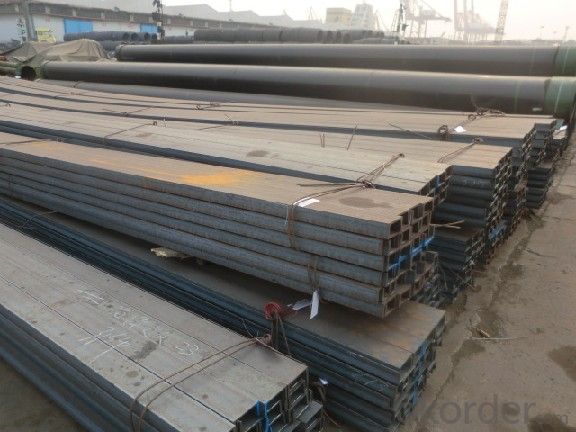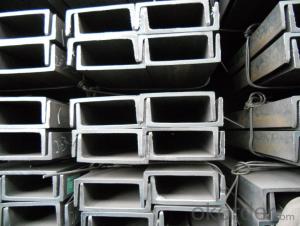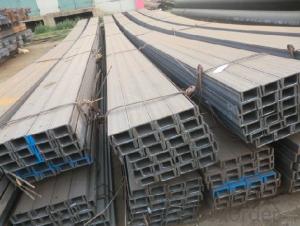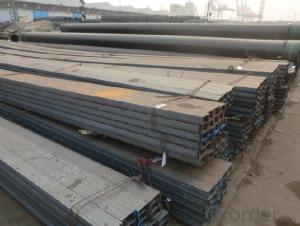JIS SS400 Steel Channel with High Quality 150mm
- Loading Port:
- Tianjin
- Payment Terms:
- TT OR LC
- Min Order Qty:
- 25 m.t
- Supply Capability:
- 10000 m.t/month
OKorder Service Pledge
OKorder Financial Service
You Might Also Like
JIS SS400 Steel Channel with High Quality 150mm
Product Description:
Standard: JIS
Material: SS400
Length: 6m, 12m
Size:
Size (mm) | Mass (Kg/m) |
150*75*5.5 | 14.66 |
150*75*6.0 | 17.90 |
150*75*6.5 | 18.60 |
Package & Delivery of JIS SS400 Steel Channel with High Quality 150mm:
1.The hot rolled channel steel will be packed in bundle with steel wire at each end of every bundle and color marking in order to help the customer to recognize his goods more easily at sight.
2. And the hot rolled channel steel could be loaded into 20ft or 40ft container, or by bulk cargo.If the weight of each bundle reaches more than 3.5 mt, the loading by break bulk cargo should be choosed.When the weight of each bundle reaches less than 3mt, the loading by container should be choosed.
3.As for the transportaion from mill to loading port, the truck will be usually used. And the maximum quantity for each truck is 40mt.
4.All in all, we could do in accordance with customer's request.
Production Flow of JIS SS400 Steel Channel with High Quality 150mm:
1.The steel billet shall be heated in the high temperature furnace.
2. The heated steel billet shall be rolled five to nine times with the aim of shaping the general figure of steel u channel.
3. The rolled steel channel should be put onto the cooling bed to make the temperature low.
4. The JIS Channel should be straighted on the straightener.
5. The straighted steel u channel will be cut into meters by saw, as per customer's requirements.
6. At the last part of production, the channel steel must be tested in order to confirm that the finished products are completely free from crack, pore, slag, scab or fold on the surface.
FAQ:
Q1: Why buy Materials & Equipment from OKorder.com?
A1: All products offered byOKorder.com are carefully selected from China's most reliable manufacturing enterprises. Through its ISO certifications, OKorder.com adheres to the highest standards and a commitment to supply chain safety and customer satisfaction.
Q2: How do we guarantee the quality of our products?
A2: We have established an advanced quality management system which conducts strict quality tests at every step, from raw materials to the final product. At the same time, we provide extensive follow-up service assurances as required.
Q3: How soon can we receive the product after purchase?
A3: Within three days of placing an order, we will arrange production. The shipping date is dependent upon the quatity, how many sizes you want and the plan of production, but is typically 1 month to 2 month days from the beginning of production.
Images of JIS SS400 Steel Channel with High Quality 150mm:


*If you would like to get our price, please inform us the size, standard/material and quantity. Thank you very much for your attention.
- Q:How are the types of I-beam and channel ABC distinguished? Tell me about it, please.
- As the name suggests, the shape of the I-beam looks on the side as "work", and the channel is square and has less surface.
- Q:Can steel channels be used for roofing applications?
- No, steel channels are not typically used for roofing applications. Roofing materials such as shingles, tiles, or metal sheets are more commonly used for this purpose.
- Q:What are the different types of connections used for steel channels in steel bridges?
- There are several types of connections used for steel channels in steel bridges, including bolted connections, welded connections, and hybrid connections. Bolted connections involve using bolts to join the steel channels together, providing flexibility and ease of installation. Welded connections involve fusing the steel channels together using welding techniques, providing a strong and permanent connection. Hybrid connections combine both bolted and welded connections, utilizing the advantages of both methods for optimal performance and ease of construction. The choice of connection type depends on factors such as design requirements, load capacity, and construction constraints.
- Q:What are the different methods for protecting steel channels from impact damage?
- There are several methods for protecting steel channels from impact damage. 1. Bumper guards: Installing bumper guards along the edges of steel channels can help prevent impact damage. These guards are typically made of rubber or other impact-resistant materials and act as a cushion to absorb the force of any potential impacts. 2. Protective coatings: Applying protective coatings to the surface of steel channels can provide an additional layer of protection against impact damage. Coatings such as paint, epoxy, or polyurethane can help minimize the effects of impacts and reduce the risk of damage. 3. Impact-resistant barriers: Placing impact-resistant barriers in front of steel channels can help absorb or deflect the force of any potential impacts. These barriers can be made of materials such as concrete, plastic, or metal, and are designed to provide a physical barrier between the channel and any potential impact. 4. Shock-absorbing materials: Using shock-absorbing materials such as foam or rubber pads can help reduce the impact force transferred to steel channels. These materials can be placed between the channel and any objects that may come into contact with it, effectively absorbing the impact energy and minimizing the risk of damage. 5. Reinforcement: Strengthening steel channels through reinforcement techniques can make them more resistant to impact damage. This can be achieved by adding additional support structures, such as braces or stiffeners, to increase the channel's structural integrity and ability to withstand impacts. 6. Proper installation: Ensuring that steel channels are properly installed and secured can help reduce the risk of impact damage. Proper alignment, anchoring, and fastening techniques can help ensure that the channels are securely in place and less susceptible to damage from impacts. It is important to consider the specific requirements and environment in which the steel channels are being used when selecting the most appropriate method for protecting them from impact damage. Consulting with experts or engineers experienced in steel channel protection can help determine the most suitable method for a particular application.
- Q:Can steel channels be used for utility supports?
- Yes, steel channels can be used for utility supports. Steel channels are strong and durable, making them suitable for supporting various utilities such as electrical cables, plumbing pipes, and HVAC systems. They provide stability and can withstand the weight and pressure of the utilities, ensuring a secure and reliable support system.
- Q:Can steel channels be used for mezzanine office spaces?
- Yes, steel channels can be used for mezzanine office spaces. Steel channels are commonly used in construction for their strength, durability, and versatility. They can be easily fabricated and installed to create a mezzanine structure that can support the weight of office spaces. Steel channels provide a stable and reliable base for the flooring, walls, and ceilings of mezzanine office spaces. Additionally, steel channels can be designed to meet specific load requirements, ensuring the safety of the structure. Therefore, steel channels are an excellent choice for creating mezzanine office spaces.
- Q:Can steel channels be used in modular data centers?
- Absolutely, modular data centers can make use of steel channels. Steel channels find wide application in construction, particularly in providing structural support and reinforcement, and this holds true for modular data centers as well. Their exceptional strength and durability make them an ideal choice for supporting heavy equipment and infrastructure within data center facilities. Steel channels can effectively frame server racks, cable trays, and other equipment mounting structures, guaranteeing stability and security within the modular data center. Moreover, steel channels can be effortlessly tailored and fabricated to meet specific design specifications, seamlessly integrating into the overall construction of the modular data center.
- Q:Can steel channels be used for industrial applications?
- Yes, steel channels can be widely used for industrial applications. They provide structural support and stability in construction, fabrication, and manufacturing processes. Steel channels offer high strength-to-weight ratio, durability, and resistance to corrosion, making them suitable for heavy-duty applications in various industries such as automotive, construction, and machinery.
- Q:What are the different methods for designing steel channels for seismic loads?
- Designing steel channels for seismic loads can be approached in several different ways. These approaches include: 1. Elastic Design Method: This method assumes that the structure maintains its linear elasticity during an earthquake. Design forces are calculated based on the seismic coefficient and applied to the channel using appropriate load combinations. The channel is then assessed for strength and stability against these design forces. 2. Plastic Design Method: This method allows the structure to experience plastic deformation during an earthquake. It involves identifying the locations of plastic hinges and calculating design forces based on expected plastic deformation. The channel is designed to possess sufficient strength and ductility to resist these forces. 3. Yielding Design Method: This method assumes that the channel will yield but not undergo significant plastic deformation during an earthquake. The yield strength of the channel is calculated, and it is designed to possess adequate strength to withstand the design forces. 4. Performance-Based Design Method: This method involves evaluating the anticipated performance of the structure during an earthquake. Factors such as desired damage level, expected ground motion, and the structure's importance are taken into account. The channel is designed to meet specific performance objectives, which may include damage limitation or ensuring occupant safety. 5. Code-Based Design Method: This method adheres to the guidelines and provisions outlined in building codes and standards. The channel is checked against the seismic design requirements specified in the code, such as the American Institute of Steel Construction (AISC) Seismic Provisions or the International Building Code (IBC). It is crucial to consider various factors, including the structure's type, the seismic activity level in the area, the desired performance objectives, and the applicable building codes and standards when selecting the method for designing steel channels for seismic loads.
- Q:What are the typical tolerances for steel channels?
- Steel channels can have varying tolerances depending on their specific application and industry requirements. Industry standards and specifications generally define the common tolerances for steel channels. Regarding dimensional tolerances, the width, depth, and thickness of steel channels typically fall within a range of ±0.005 to ±0.030 inches. These tolerances ensure that the steel channels meet the desired dimensions accurately, enabling them to be assembled or integrated into various structures or systems. For straightness, steel channels usually have a tolerance of 1/8 to 1/4 inch over a specified length. This ensures that the channels can be easily aligned and installed without significant deviations. Surface finish tolerances are also crucial for steel channels as they affect both appearance and functionality. Roughness measurements like Ra (average roughness) or Rz (mean roughness depth) define the typical tolerances for surface finish. Depending on the specific application requirements, these tolerances can range from 20 to 125 microinches for Ra and 100 to 600 microinches for Rz. It is essential to note that these tolerances serve as general guidelines, and the actual tolerances may differ based on the manufacturing process, industry standards, and customer specifications. Therefore, it is advisable to consult the relevant standards or communicate with the steel channel manufacturer to determine the specific tolerances required for a particular application.
1. Manufacturer Overview |
|
|---|---|
| Location | |
| Year Established | |
| Annual Output Value | |
| Main Markets | |
| Company Certifications | |
2. Manufacturer Certificates |
|
|---|---|
| a) Certification Name | |
| Range | |
| Reference | |
| Validity Period | |
3. Manufacturer Capability |
|
|---|---|
| a)Trade Capacity | |
| Nearest Port | |
| Export Percentage | |
| No.of Employees in Trade Department | |
| Language Spoken: | |
| b)Factory Information | |
| Factory Size: | |
| No. of Production Lines | |
| Contract Manufacturing | |
| Product Price Range | |
Send your message to us
JIS SS400 Steel Channel with High Quality 150mm
- Loading Port:
- Tianjin
- Payment Terms:
- TT OR LC
- Min Order Qty:
- 25 m.t
- Supply Capability:
- 10000 m.t/month
OKorder Service Pledge
OKorder Financial Service
Similar products
New products
Hot products
Related keywords





























